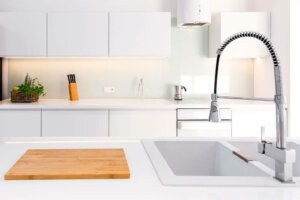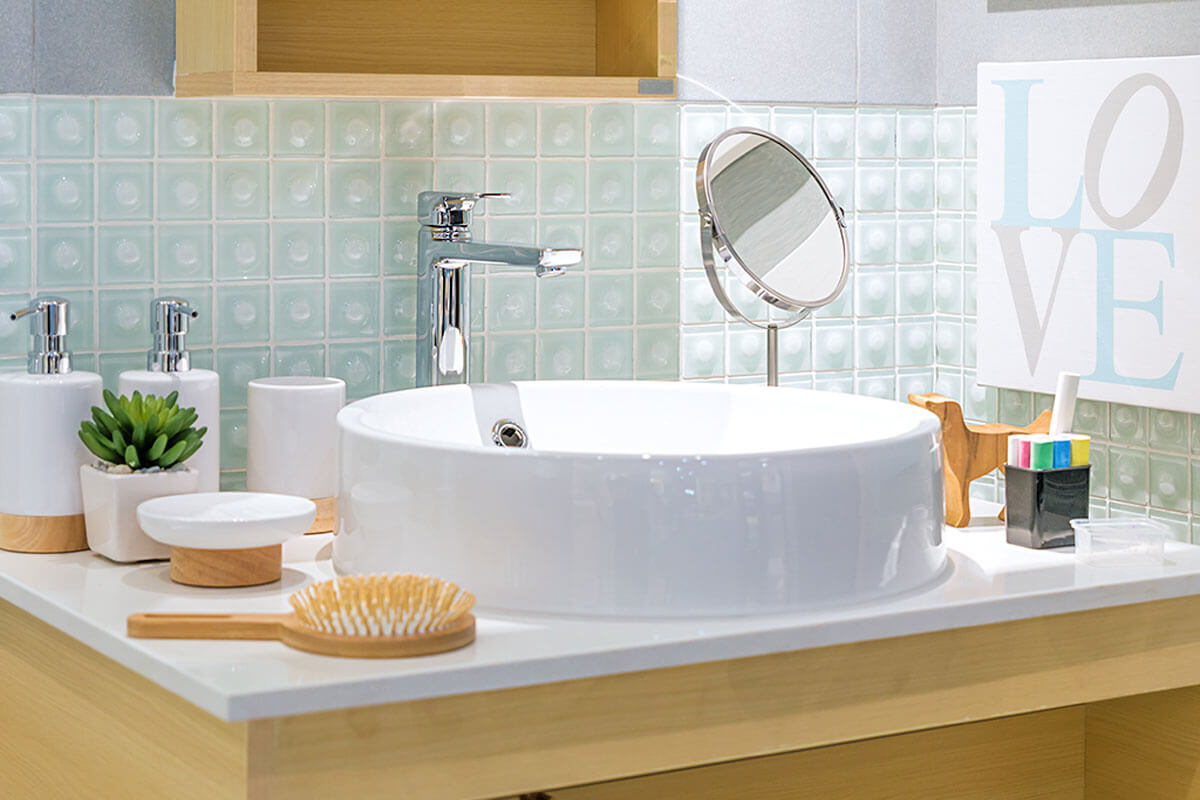Kitchen or Bathroom: Where Are The Most Germs?

Which place do you think has the most germs? The kitchen or the bathroom? If it’s a quick response, chances are that we’d all bet on the bathroom. However, this isn’t quite so. The place with the most germs is the kitchen. Surprised? Read on and find out why.
Although the reality is that in our homes there isn’t a single place free of germs or dirt, there are some spaces that take the crown. In this case, for example, we’re debating whether there are more in the bathroom or the kitchen because the truth is that in both spaces there are.
The great difference between one and the other, in addition to the quantity and origin of the germs, lies in the activities we do in each place and how harmful these microorganisms can be. Therefore, in addition to giving you a quick and correct answer, we want to explain in-depth where these germs come from.
Germs in the bathroom

In most homes, we’re predisposed to excessive cleaning of the bathroom, just because it’s the bathroom. We assume that entering again and again during the day is the source of germs in the home. More because it’s clear that fecal bacteria and other germs can creep up the toilet and through the pipes.
This is the reason why it’s normal for everyone at home to have their own cleaning supplies, even if they share the bathroom. Well, in this way an invisible barrier is made between the bacteria in the environment and those that each person can bring from the outside or have naturally.
In addition to the extensive cleaning days that we perform in the bathroom, having personal hygiene implements makes the bathroom, by far, one of the cleanest areas. Think about it, almost daily we clean floors, toilets, sinks, and showers.
Cooking and germs: what does science say?
Studies have shown that in the kitchen there are a large number of microorganisms that, without being able to see with the naked eye, are present and can put our health at risk. When taking samples, the researchers found that the most common germs in this space are:
- Coliforms.
- Fecal coliforms.
- Escherichia coli.
- Staphylococcus aureus.
- Salmonella.
- Campylobacter.
- Listeria.
The most prevalent, according to this study, were fecal coliforms, a percentage of predominance in 44 percent of the households analyzed. These bacteria were found in kitchen sinks, sponges, and rags. Second, S. aureus was found in 39 percent of the samples, present on countertops and refrigerator door handles.
In what parts of the kitchen do we find the most germs?

Once the kitchen has been defined as the most polluted place in our home, it’s important to keep in mind where these germs accumulate. Only in this way is it possible to perform forceful cleaning with a view to keeping the area free of these microorganisms.
Putting aside the comparison between the kitchen and the bathroom in search of where there are more germs, studies in which 14 sites of the kitchens and the bathrooms of the homes have been monitored monthly, have established where the highest concentrations of bacteria are. They were found in those areas where humidity was more conserved, such as:
- Sponges
- Kitchen cleaning materials
- Drains
- Sink
- Faucets
How can I prevent the transfer of bacteria from the bathroom to the kitchen?
One of the proposed measures, from the point of view of public health and based on scientific evidence, is to put multiple environmental barriers that favor the eradication of these microorganisms. For example, executing a good hygiene protocol at home will eliminate present germs and prevent their rapid proliferation.
In addition, it’s important to carry out measures such as hand washing, especially when cooking. This, taking into account that we can move bacteria from the bathroom or other spaces to the food that we’ll prepare and consume. The same can happen the other way around, not washing the food we bring from outside well, touching it, and touching other things at home can spread bacteria.
One of the products that contribute the most to keeping the kitchen and bathroom clean, as well as any other place where germs are present, is hypochlorite. But there are also other, more commercial products and those with extra features that you can also use.
Which place do you think has the most germs? The kitchen or the bathroom? If it’s a quick response, chances are that we’d all bet on the bathroom. However, this isn’t quite so. The place with the most germs is the kitchen. Surprised? Read on and find out why.
Although the reality is that in our homes there isn’t a single place free of germs or dirt, there are some spaces that take the crown. In this case, for example, we’re debating whether there are more in the bathroom or the kitchen because the truth is that in both spaces there are.
The great difference between one and the other, in addition to the quantity and origin of the germs, lies in the activities we do in each place and how harmful these microorganisms can be. Therefore, in addition to giving you a quick and correct answer, we want to explain in-depth where these germs come from.
Germs in the bathroom

In most homes, we’re predisposed to excessive cleaning of the bathroom, just because it’s the bathroom. We assume that entering again and again during the day is the source of germs in the home. More because it’s clear that fecal bacteria and other germs can creep up the toilet and through the pipes.
This is the reason why it’s normal for everyone at home to have their own cleaning supplies, even if they share the bathroom. Well, in this way an invisible barrier is made between the bacteria in the environment and those that each person can bring from the outside or have naturally.
In addition to the extensive cleaning days that we perform in the bathroom, having personal hygiene implements makes the bathroom, by far, one of the cleanest areas. Think about it, almost daily we clean floors, toilets, sinks, and showers.
Cooking and germs: what does science say?
Studies have shown that in the kitchen there are a large number of microorganisms that, without being able to see with the naked eye, are present and can put our health at risk. When taking samples, the researchers found that the most common germs in this space are:
- Coliforms.
- Fecal coliforms.
- Escherichia coli.
- Staphylococcus aureus.
- Salmonella.
- Campylobacter.
- Listeria.
The most prevalent, according to this study, were fecal coliforms, a percentage of predominance in 44 percent of the households analyzed. These bacteria were found in kitchen sinks, sponges, and rags. Second, S. aureus was found in 39 percent of the samples, present on countertops and refrigerator door handles.
In what parts of the kitchen do we find the most germs?

Once the kitchen has been defined as the most polluted place in our home, it’s important to keep in mind where these germs accumulate. Only in this way is it possible to perform forceful cleaning with a view to keeping the area free of these microorganisms.
Putting aside the comparison between the kitchen and the bathroom in search of where there are more germs, studies in which 14 sites of the kitchens and the bathrooms of the homes have been monitored monthly, have established where the highest concentrations of bacteria are. They were found in those areas where humidity was more conserved, such as:
- Sponges
- Kitchen cleaning materials
- Drains
- Sink
- Faucets
How can I prevent the transfer of bacteria from the bathroom to the kitchen?
One of the proposed measures, from the point of view of public health and based on scientific evidence, is to put multiple environmental barriers that favor the eradication of these microorganisms. For example, executing a good hygiene protocol at home will eliminate present germs and prevent their rapid proliferation.
In addition, it’s important to carry out measures such as hand washing, especially when cooking. This, taking into account that we can move bacteria from the bathroom or other spaces to the food that we’ll prepare and consume. The same can happen the other way around, not washing the food we bring from outside well, touching it, and touching other things at home can spread bacteria.
One of the products that contribute the most to keeping the kitchen and bathroom clean, as well as any other place where germs are present, is hypochlorite. But there are also other, more commercial products and those with extra features that you can also use.
All cited sources were thoroughly reviewed by our team to ensure their quality, reliability, currency, and validity. The bibliography of this article was considered reliable and of academic or scientific accuracy.
- Borrusso, P. A., & Quinlan, J. J. (2017). Prevalence of Pathogens and Indicator Organisms in Home Kitchens and Correlation with Unsafe Food Handling Practices and Conditions. Journal of Food Protection, 80(4), 590–597. https://doi.org/10.4315/0362-028X.JFP-16-354
- Sinclair, R. G., & Gerba, C. P. (2011). Microbial contamination in kitchens and bathrooms of rural Cambodian village households. Letters in Applied Microbiology, 52(2), 144–149. https://doi.org/10.1111/j.1472-765X.2010.02978.x
- Rusin, P., Orosz-Coughlin, P., & Gerba, C. (1998). Reduction of faecal coliform, coliform and heterotrophic plate count bacteria in the household kitchen and bathroom by disinfection with hypochlorite cleaners. Journal of Applied Microbiology, 85(5), 819–828. https://doi.org/10.1046/j.1365-2672.1998.00598.x
- Stambullian, J., Rossotti, D., Fridman, D., Luchetti, P., Cheade, Y., & Stamboulian, D. (2011). Eficacia de cinco desinfectantes para la reducción bacteriana doméstica [Efficacy of five disinfectants to reduce bacterial load in the household]. Medicina, 71(3), 218–224.







